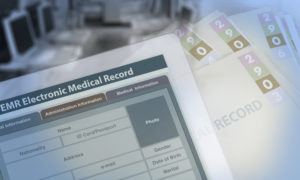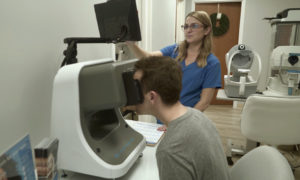By Mark Wright, OD, FCOVD,
and Carole Burns, OD, FCOVD

May 6, 2020
Many people use the terms telehealth, telemedicine and teleoptometry interchangeably. As part of the medical system of care of our patients, we need to conform to the accepted medical system of terminology. Since we are at the beginning of the use of remote health-care services, we are at a place where we should define terms.
Here are three considerations showing that the best term to use is telemedicine when an individual doctor is delivering remote diagnosis and treatment services to an individual patient.
CONSIDERATION 1: The Difference Between EHR & EMR Gives Guidance
This discussion began a long time ago with the difference between electronic health records (EHR) and electronic medical records (EMR).
An EMR is the digital record of a patient’s medical information primarily obtained in the individual practitioner’s office. The EHR is much more. The EHR contains the entire universe of all of each individual patient’s health information.
The EHR for an individual patient contains all clinicians’ records involved in the care of that patient plus any personal health information about the patient including wellness and lifestyle data, as well as data from their FitBit or their 23andMe report. The local doctor’s EMR is a subset of the patient’s total EHR.
This leads us to the understanding that the local doctor’s telemedicine exam and treatment is a subset of the patient’s overall health record from all practitioners.
CONSIDERATION 2: National Organizations Give Guidance
The U.S. Department of Health and Human Services (HHS) identifies telehealth’s definition as broader in scope than that of telemedicine. According to the HHS, telehealth covers remote health-care services that are both clinical and non-clinical. Telemedicine refers just to remote clinical services.
Medicaid uses the telemedicine terminology to define the local doctor’s remote examination and treatment.
Other Articles to Explore
The American Telemedicine Association gives the following definition …
“Telehealth and Telemedicine: Telemedicine is the use of medical information exchanged from one site to another via electronic communications to improve patients’ health status.
Closely associated with telemedicine is the term “telehealth,” which is often used to encompass a broader definition of remote healthcare that does not always involve clinical services. Videoconferencing, transmission of still images, e-health including patient portals, remote monitoring of vital signs, continuing medical education and nursing call centers are all considered part of telemedicine and telehealth.”
CONSIDERATION 3: No Third Party Pays for Tele-Optometry Services
As far as we are aware, tele-optometry is not a paid service by any medical third party.
Imagine what would happen to medical third-party payments if optometrists stopped billing for medical eye examinations and started billing for “optometric medical eye examinations.” Since no such code exists, payments would stop immediately. This suggests we should use the telemedicine terminology versus teleoptometry.
This is not a new idea. Many years ago, optometry thought it was a good idea to create its own codes to use (COIT and VOIT) instead of using the medical standard of CPT and ICD codes. The mere absence of COIT and VOIT today informs us how successful the approach of going outside standard medical terminology turns out.
CONFUSION
There is a lot of confusion that currently exists. Many people continue to use the terms telehealth and telemedicine interchangeably. One of the most common examples of this confusion is when it is written as “telehealth/telemedicine services.” Rather than choose, both terms are used to cover all bases.
You will also see other professions struggling with the same issues this article discusses by calling what they do as tele-psychiatry or tele-radiology.
CONCLUSION
Looking at how long the confusion between the use of the terms EHR and EMR has existed, the confusion between telehealth, telemedicine, and tele-optometry is not going to go away quickly. We can help this situation by being clearer on our use of the term telemedicine when referring to the remote examination and treatment of an individual patient by an individual practitioner.
References
i. https://financesonline.com/difference-ehr-emr/
ii. https://www.hhs.gov/sites/default/files/telehealth-faqs-508.pdf
iii. https://www.medicaid.gov/medicaid/benefits/telemedicine/index.html
iv. https://thesource.americantelemed.org/resources/telemedicine-glossary
v. https://www.psychiatry.org/psychiatrists/practice/telepsychiatry
vi. https://evisit.com/resources/what-is-teleradiology/




























